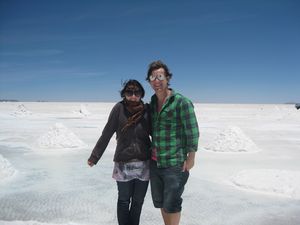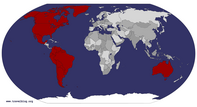Advertisement
Published: November 5th 2010

 The Boss and I
The Boss and I
On the Salt FlatsDay One - The Only Day Worth Doing
We ate breakfast at a local cafe where the lady who ran the Hostelling International found us. We gave her a B$100 note to which she replied she didn’t have change.
“Well that’s all I’ve got,” said the Boss with a shrug. The woman went to a nearby store and bought a bottle of Sprite to break the note.
After breakfast we headed around to Expedicionez Lipez, the travel agent where we’d booked the trip. We’d been told to be there by 10:15 and, at 10:20, we were worried we’d be pushing it. However we arrived to find the footpath out front of the office littered with people and backpacks and the office itself locked up.
We waited the better part of a half hour before someone arrived to open the office. Their lateness was to be expected but really it was the first of what was to be a lot of small disappointments that led to the whole thing feeling like a bit of a scam. The two “guides” turned up and we were told by the English speaking bloke who ran the office and sold the trips that the “guides” only
spoke Spanish. When we pointed out that the sign out the front of the office said “professional English speaking guide”, the English speaking scammer explained that the sign was correct - they had an English speaking guide, but he had gone on yesterday’s trip.
It wasn’t until almost 11:30 that the two Toyota Land Cruisers had all the bags on the roof racks and the travellers in their seats. The back Land Cruiser had an English couple, a Dutch couple, a Canadian and a Kiwi. Our car had four girls who had studied medicine together in Austria. Steffi, Renata and Undine were Austrians and ____ (I'll try remember it) was from Germany. The four of them were all very sweet and made an effort to speak in English so that the Boss and I would feel included. Furthermore, they spoke Spanish, so were able to act as a translator for the guide to us. The Boss and I piled in to the far back seats of the car and we took off.
Not ten minutes later we were at our first site - Uyuni’s train graveyard. Though in recent times Uyuni had become a tourism hub (being so close to

 Me and a dead armadillo
Me and a dead armadillo
Admittedly, I thought it was sleepingthe Salt Flats), previously it had been a centre for rail travel and so on the outskirts of town and just off the train lines were dozens of abandoned engines and coaches. Initially I thought it was a fairly ridiculous thing to put on the tour (honestly, I still believe it was a bit of a time filler) but it ended up being kind of interesting. I was particularly impressed with the graffiti covering the trains - where many towns have old abandoned buildings covered in tags and swear words, these trains were covered in the mathematical theories of Einstein and Newton!
Our next stop was the town of Colchani, where they sold, wait for it... Salt. To be fair, it wasn’t just stalls and stalls of table salt and salt licks, they actually made things out of the salt. There were salt ash trays, salt dice, salt llama figurines - you get the picture. There was also a salt “museum” (the first of many that weren’t actually museums at all) which had a series of massive salt animals, including a llama that you could get a photo riding on and a salt bird and salt armadillo with a stuffed

 The Boss
The Boss
On a giant salt Llamabird and armadillo on them respectively so you knew what they were.
From there we entered the salt flats. At over 10,000 square kilometres, it is the largest salt flat in the world. And really, that about sums it up - it’s a flat surface covered with piles of white powder, kind of like Kate Moss’s chest. Our “guide” explained that the salt flat was up to three metres deep of salt in places but that there was water running beneath the surface, so it wasn’t solid salt. Men were scattered over the plain digging up the salt, putting it in to piles to let it dry and then it was carted away to be refined. I thought it would have to be the least fulfilling job of all time. Hundreds of generations of the same family could work digging up the salt and never finish that job. But I suppose on the other hand, there would always be a job for someone who knew how to dig salt.
We continued for another half hour before reaching the Salt Hotel. Built in the early ‘90’s it was the first of its kind, is the only one situated in the middle

 The Salt Hotel
The Salt Hotel
Not the one we stayed inof the Salt Flats and just about everything - the walls, furniture, floor - was made out of salt. Whilst there, I managed to stand at the back of a tour group who had an English speaking guide. He explained that the natives of Bolivia had always believed that the salt flat was like a giant sheet of ice - quite thin in some places - and so had always feared venturing too far out on to it. It wasn’t until the 1940’s that a group first crossed the flat, taking a week to do it as they tested the thickness as they went (these days, he said, they land aeroplanes on it, so I guess it’s pretty thick!) The astronauts, looking down on the Earth in the 60’s and 70’s, had seen a large spot that reflected the sun’s light and had been particularly fascinated by it. Obviously it turned out to be the Salt Flats and this led to a series of academic papers published on the site in the 70’s and 80’s, which eventually led to tourist curiosity in the 90’s. It was this sudden boom in tourism that had led to the Salt Hotel being built,
although it had been closed down in 2003 due to their lack of a septic tank - they had simply been pumping their refuse in to the ground and polluting the area. A few years later they had a large septic tank installed and had been allowed to re-open, although to use their toilet they charged B$5, a price the Boss felt did not reflect the quality of the facilities.
We ate lunch of meat, quinua (a delicious, rice-like food) and veggies before getting back in to the car and heading for the Incahuasi Island. Also known as the Cactus Island or the Fish Island, Incahuasi is a cactus covered island of rock in the middle of the salt flat. We spent an hour there, exploring the island, admiring the cactus - including one over 900 years old standing over 9 metres tall - and then taking perspective photos. Since the salt flat is more or less completely the same for hundreds of kms, it has become famous for people putting an object in the foreground of a photo then walking a few metres back from the object so it appears large and the person appears small. We saw people
with dinosaurs, Dora the Explorer, Pringle tins and other objects which I’m sure made for hilarious photos. The Boss and I had a bottle of water. Ours weren’t so great.
Our final hour in the car was the drive to another salt hotel on the edge of the flat. Again, most everything was made out of salt, including the bed. But after the vortex beds of Uyuni’s Hostelling International, the salt bed was pure heaven. Dinner was lasagne, which was ok but I’m yet to have a good bolognaise in South America, for some reason it always ends up tasting tangy as vegemite. Dinner was interrupted by two groups of children from the local town who sang loudly and poorly, shuffled their feet and then walked around the tables holding their hats out expecting money. As an older brother of four siblings, I have no qualm with going along to see little kids attempt to sing and dance and I’ll even give them a clap but if they want money, they really should pick up their act. I gave one kid a boliviano, he went to everyone else at the table who gave him nothing, so he came back to
me again. When I gave him nothing he scowled at me and left. I decided to never again give money to these little punks who perform poorly, without being asked and then make out that you’re the bad guy. Yes, I’m becoming jaded.
Advertisement
Tot: 0.133s; Tpl: 0.012s; cc: 8; qc: 41; dbt: 0.0342s; 1; m:domysql w:travelblog (10.17.0.13); sld: 1;
; mem: 1.1mb












